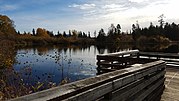Larsen Lake
History

Historically, Phantom Lake drained into Larsen Lake through the marshy, low-lying region between them. This watershed then drained into Kelsey Creek and Lake Washington. In the 1880s, settlers redirected the outflow of Phantom Lake into nearby Lake Sammamish through what is now Weowna Creek. This drained the area for agriculture. In 1987, some water was allowed to flow back through the original wetland to restore the habitat.
The lake is named for Ove Peter and Mary Larsen, immigrants from Denmark who homesteaded the surrounding land in 1889. In 1913, the Aries brothers purchased the land from the Larsens and established a farm. The blueberry farm was created by Louis Weinzirl in 1944.
Description
Larsen Lake is located in the Lake Hills neighborhood of Bellevue, and is connected to nearby Phantom Lake by the Lake Hills Greenbelt, a trail and wetland. The lake is popular for fishing, and there is a public fishing dock. Much of stormwater runoff from the area drains into Larsen Lake and Kelsey Creek.
The farm at Larsen Lake is popular with residents and tourists, and includes U-pick blueberries. In 1995, the blueberry farm suffered from a devastating fungal outbreak. The use of fungicide to stop the outbreak led to controversy since the farm lost its organic status.
References
- ^ "Stream Report". King County.
- ^ "Bellevue Biography: Ove Peter and Mary Larsen". Bellevue Reporter.
- ^ "Larsen ('Blueberry') Lake | Heritage Corner". Bellevue Reporter.
- ^ "Lake Hills Greenbelt". Washington Trails Association.
- ^ "Washington Department of Fish and Wildlife". Larsen Lake.
- ^ "Characterizing and Controlling Urban Runoff Through Street and Sewerage Cleaning". EPA.
- ^ "City of Bellevue, WA". Blueberry Farms.
- ^ "Washington declared a powerhouse for blueberries by WSDA". King5.
- ^ "Blueberry Farm Is 'Organic' No Longer – Fungicide Spraying Dismaying To Some". The Seattle Times.

